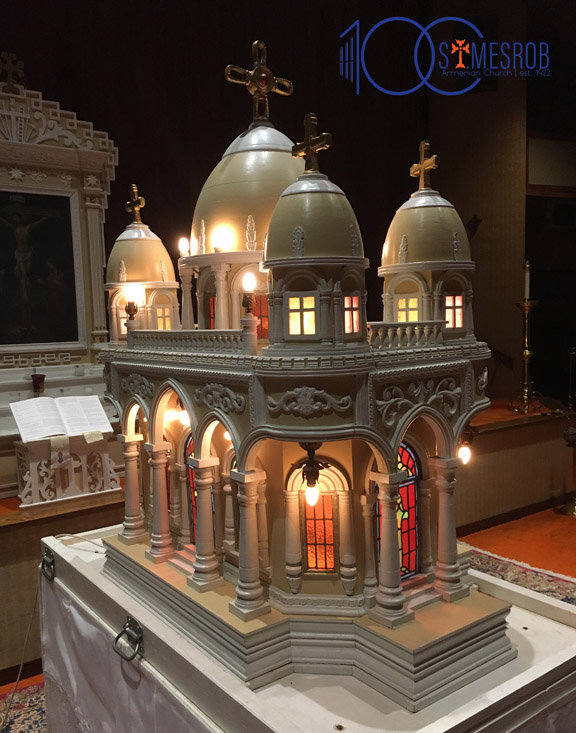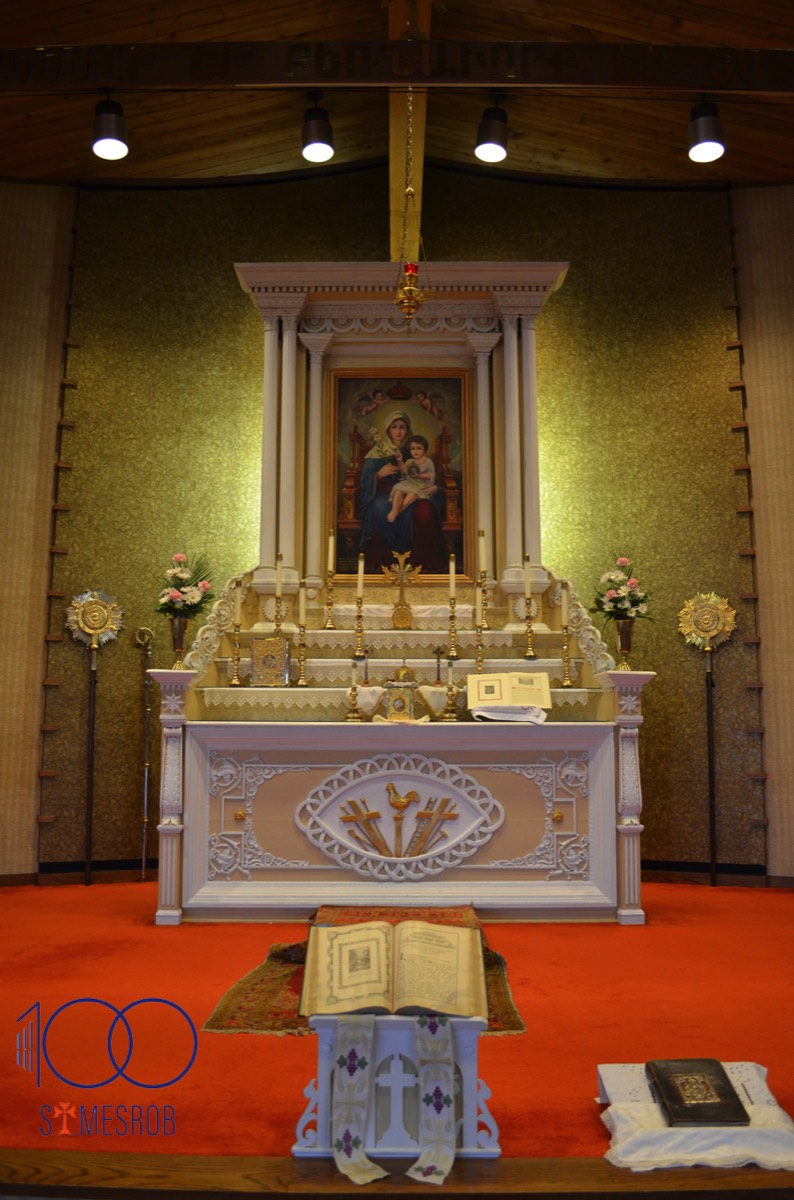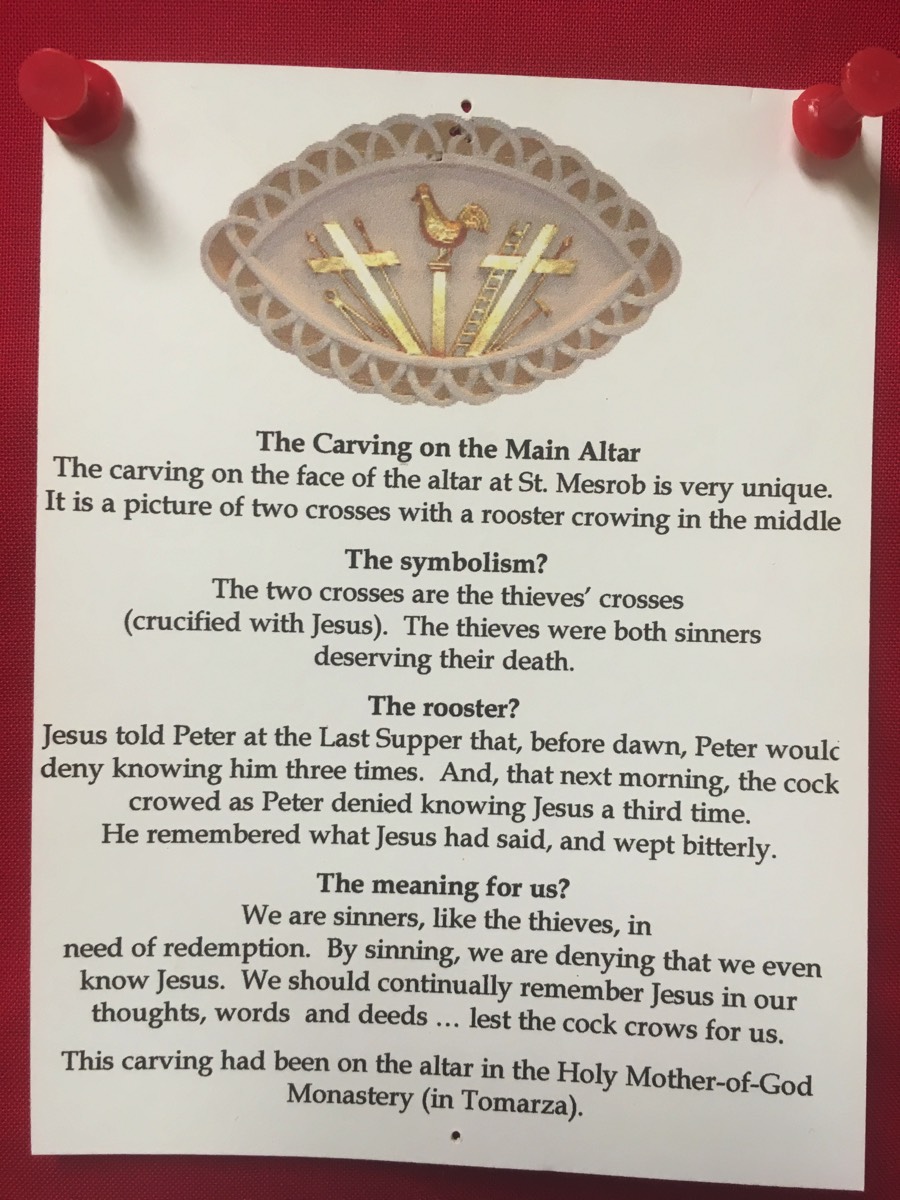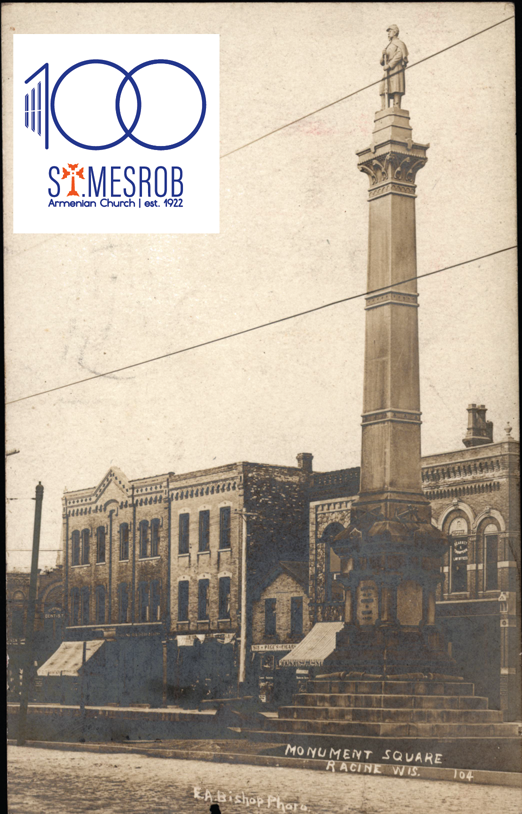Centennial Spotlight

April 2022
The Kerezman
"Kerezman." If you look up the word it translates to Holy Sepulcre. We at St. Mesrob Church know the kerezman as a replica of an ornate house or building which could resemble the outside of a very large, fancy dollhouse. Made of solid wood, and thus very heavy, it has two stories, columns and railings around the perimeter, many arched windows and doors which have amber glass inserts and are lighted from the inside. The outside is painted white and the roof has multiple domes decorated with gold colored metal. It is absolutely beautiful!
Referred to as the “tomb” or “grave” of Christ, this unique edifice was hand built by a passionate artisan, Sahag Jansouzian, in 1935. Mr. Jansouzian was one of the early members of St. Mesrob, and though we don’t have information why he built the kerezman, we know that he personally designed and built it. By day, he was a laborer at a local factory, so it was after work that he took 18 months to complete all its many intricate details. (He also made a huge arch supported by columns that were built over the entire kerezman. It’s thought that the arch represented the wings of the myriad of angels.)
As to why the tomb was so ornate. The answer is in John 2:12-22. The Passover of the Jews was at hand, and Jesus went up to Jerusalem. In the temple he found those who were selling oxen and sheep and pigeons, and the money-changers sitting there. And making a whip of cords, he drove them all out of the temple, with the sheep and oxen. And he poured out the coins of the money-changers and overturned their tables. And he told those who sold the pigeons, “Take these things away; do not make my Father’s house a house of trade.” His disciples remembered that it was written, “Zeal for your house will consume me.” So the Jews said to him, “What sign do you show us for doing these things?” Jesus answered them, “Destroy this temple, and in three days I will raise it up.” The Jews then said, “It has taken 46 years to build this temple, and will you raise it up in three days?” But he was speaking about the temple of his body. This explains why the kerezman resembles a glorious palace. The tomb gives us the Kingdom. (Heaven will be glorious!)
At St. Mesrob, the kerezman is of course highly and ceremoniously regarded. Brought out for display (sans the arch) for Good Friday services, it’s decorated lavishly with fresh flowers and sits on the main altar. Then, as the service culminates, it’s taken to the back of the church, held high by strong young men* so that worshiping parishioners may pass, most often tearfully, underneath it. Doing so, shows that you are entering the tomb of Christ. We want to be with Christ, even in his death. (Parishioners walking beneath the tomb won’t forget the experience for a long time.) The kerezman is then returned to the altar where it is displayed and honored for 40 days after Easter.
*In days past, families would pay for their young sons to be selected to hold the kerezman on Good Friday.
March 2022
SUNDAY SCHOOL
Amazing fact: the St. Mesrob Sunday School was the first founded by an Armenian Apostolic Church in the Americas.
Church building purchased, repairs and alterations made, so what’s next? Sunday School? Not immediately. Rather there was formed a Fraternity of the Armenian Apostolic Church which was basically a library of donated books and newspapers, a place for lectures and educational gatherings. Somehow Armenian School was incorporated. However, in subsequent years, according to historical notes, the Fraternity with its emphasis on Christianity rather than ethnicity lost support and ceased after a short existence.
In October 1935, after approval by what was later to become the Diocese, the St. Mesrob Armenian Sunday School was established. It would be organized and headed by one of the parish’s founding members, Toros Madaghjian. Mr. Madaghjian had worked tirelessly in the preceding years to obtain approval to institute the Sunday School. Its initial class was held with eight instructors and approximately 50 students. (In the early years, some instructors were devout Christians, but not Armenians!)
Agenda for each Sunday started with a general assembly with the superintendent (Mr. Madaghjian) leading the opening prayer, delivering a devotional talk and making announcements. Then a 15-minute singing of hymns (remember, “Onward Christian Soldiers“?), and the assembly would disperse into graded classes. Favorite memories of early Sunday School were birthdays; it was always someone’s birthday which would be celebrated by a loud rendition of the Happy Birthday song in Armenian! Another was the annual Christmas Pageant on Christmas Eve (what did other people do on Christmas Eve?). And remember the cross and crown pin award system for perfect attendance? Don’t forget to put your nickel or dime in the collection plate. Can you name your Sunday School teachers?
Since its founding, St. Mesrob’s Sunday School continued without interruption on a year-round basis … until 1968 when a summer recess was instituted. Sunday School continues today with a formal teaching curriculum issued from the Diocese. Classes are fewer and smaller, but still have enthusiastic teachers and children. May God continue to bless our beloved St. Mesrob Sunday School.


February 2022
Our Altar
The original church building was purchased in October of 1924; the former Danish Baptist Church at 1326 State Street, Racine, Wisconsin. Now to hold Divine Liturgy, they required a proper Armenian altar. That wasn’t a simple need. It was good fortune that this parish was made up of artisans and carpenters who could do the design and work. So additional money was spent for repairs, renovations and changes to conform with standards set by the Diocese. The altar with its intricate carving was fashioned and built by Avak Kalfa Akgulian, the altar and door paintings were done by his cousin, Gulbank Akgulian, and The Holy Sepulcre (white tomb used at Easter) was built by Sahag Jansouzian. Amazingly, those magnificent artisans have close living descendants who are members of our current parish. The altar was styled after the one left behind in Tomarza, Turkey, from where the majority of Racine parishioners immigrated.
In 1973, the altar was moved from State Street to the newly built church on Erie Street. The original altar construction included more detail and scrolling than its new location could hold. So unfortunately some pieces of it had to be removed to accommodate the space in the new church. Adding to the beauty of the altar structure are the lovely lace cloths which are laundered and pressed with special care. The cross applied to the curtain in the current church was also brought from the State Street Church. (An interesting note about the curtain rod in our present church are the brass letters in Armenian which tell us to “Come to me all you who are weary and burdened and I will give you rest.” Matthew 11:28)
As we worship on Sundays, know that the altar at which Divine Liturgy is celebrated – including the beautiful painting of Mary and the Christ Child – has survived nearly 100 years. May our faith be as enduring.

This calendar year 2022 is 100 years since the start of the St. Mesrob Church’s first Divine Liturgy as a parish in 1922. It wasn’t the first time that Badarak had been celebrated as a group, as that had happened many years before. Some Armenian settlers were here in Racine as early as 1914 or before, and they attended church services once or twice a year when a visiting priest came to Racine from the Chicago area. Services were held in a public hall or later in the Episcopal Church located in downtown Racine. But in 1922, there were enough Armenian people – families – who had arrived and settled in Racine to become a parish of their own. No longer part of a larger regional church, they appealed to the church hierarchy and asked to be accepted as a parish. That was granted in 1922!
In 1923-24, hard-working church leaders were able to secure the services of a full-time priest: Father Vartan Davitian. Then in 1925, after long deliberations between many parties, it was finalized that the church at 1326 State Street would be purchased – from a Danish parish – for the sum of $18,000. Named by a church sponsor in memory of his father’s name it became: St. Mesrob Armenian Apostolic Church. It was reported that the “gorgeous church was a gift of God presented to the Armenians of Racine.”